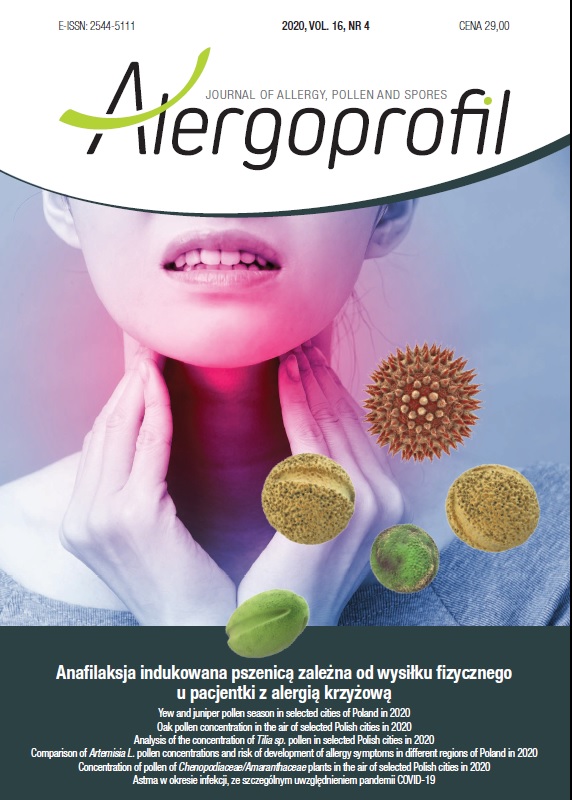Analysis of the concentration of Tilia sp. pollen in selected Polish cities in 2020 Original article
##plugins.themes.bootstrap3.article.main##
Abstrakt
With their numerous natural and functional values, lime trees are recommended for planting in urban greenery. However, the allergenic properties of lime pollen should be taken into account. The aim of the study was to analyze the concentration of airborne lime pollen and the course of pollen seasons in this taxon in 10 cities in Poland in 2020. The aerobiological analyses were carried out in Bialystok, Bydgoszcz, Cracow, Lublin, Olsztyn, Opole, Piotrkow Trybunalski, Sosnowiec, Szczecin, and Warsaw.
The investigations were conducted with the volumetric method using Burkard or Lanzoni pollen samplers. The 98% method was employed to determine the length of the pollen season. The earliest onset of the lime pollen season was recorded in Opole and Warsaw (June 14th), and the latest date was noted in Sosnowiec (June 23rd). The maximum lime pollen concentrations were reported between July 1st and July 6th in most cities and on June 24th only in Lublin and Opole. The highest annual pollen sums were recorded in Lublin (738), similar to those reported in 2018 and 2019, whereas the lowest values were noted in Bialystok (20), Sosnowiec (145), and Olsztyn (149). The annual sums of lime pollen in the other measurement sites located in the different regions of Poland were in the range of 180–308.
In the discussion, the results from 2020 for Lublin are compared with data from the previous 19 years collected in this city. The data suggest that the increase in the airborne lime pollen concentration recorded in Lublin in recent years may be associated with climate change.
Pobrania
##plugins.themes.bootstrap3.article.details##

Utwór dostępny jest na licencji Creative Commons Uznanie autorstwa – Użycie niekomercyjne 4.0 Międzynarodowe.
Copyright: © Medical Education sp. z o.o. This is an Open Access article distributed under the terms of the Attribution-NonCommercial 4.0 International (CC BY-NC 4.0). License (https://creativecommons.org/licenses/by-nc/4.0/), allowing third parties to copy and redistribute the material in any medium or format and to remix, transform, and build upon the material, provided the original work is properly cited and states its license.
Address reprint requests to: Medical Education, Marcin Kuźma (marcin.kuzma@mededu.pl)
Bibliografia
2. Seneta W, Dolatowski J. Dendrologia. Wydawnictwo Naukowe PWN, Warszawa 2009.
3. Błażejczyk K, Kuchcik M, Błażejczyk A et al. Assessment of urban thermal stress by UTCI – experimental and modelling studies: an example from Poland. Die Erde. 2014; 4(3): 105-16. https://doi.org/10.12854/erde-144-8.
4. Konarska A. Preliminary studies on the structure of sepals and trichomatous nectaries in flowers of Tilia cordata Mill. Acta Sci Pol Hortorum Cultus. 2013; 12(2): 63-74.
5. Szopińska E, Zygmunt-Rubaszek J. Propozycje standardów w zakresie kształtowania zieleni wysokiej miejskich tras komunikacyjnych. Wrocław 2010. https://www.zzm.wroc.pl/userdata/Propozycje_standardow_opracowanie_katalog%5B1%5D.pdf (access: 29.10.2020).
6. Pritsch G. Bienenweide. Franckh-Kosmos Verlags-GmbH and Co. KG, Stuttgart 2018.
7. Lipiński M. Pożytki pszczele. Zapylanie i miododajność roślin. Powszechne Wydawnictwo Rolnicze i Leśne. Wydawnictwo Sądecki Bartnik, Warszawa 2010.
8. Somme L, Moquet L, Quinet M et al. Food in a row: urban trees offer valuable floral resources to pollinating insects. Urban Ecosyst. 2016; 19: 1149-61. https://doi.org/10.1007/s11252-016-0555-z.
9. Weryszko-Chmielewska E, Piotrowska-Weryszko K, Dąbrowska A. Response of Tilia sp. L to climate warming in urban conditions – Phenological and aerobiological studies. Urban For. Urban Green. 2019; 43: 126369. https://doi.org/10.1016/j.ufug.2019.126369.
10. Szczepanek K. Wytwarzanie i rozprzestrzenianie spor i ziaren pyłku. In: Dybova-Jachowicz S, Sadowska A (ed). Palinologia. Instytut Botaniki im. W. Szafera. PAN, Kraków 2003.
11. Mrđan S, Ljubojević M, Orlović et al. Poisonous and allergenic plant species in preschool’s and primary schools’s yard in the city of Novi Sad. Urban For Urban Gree. 2017; 25: 112-9.
12. Felber F, Clot B, Leimgruber-Bosset A et al (ed). Plantes, pollen et allergies, les Cahiers du Jardin vol. 3, Jardin botanique de l’Université et de la Ville de Neuchâtel 2003.
13. Smith M, Jäger S, Berger U et al. Geographic and temporal variations in pollen exposure across Europe. Allergy. 2014; 69(7): 913-23. https://doi.org/10.1111/all.12419.
14. Puc M, Wolski T, Câmara Camacho I et al. Fluctuation of birch (Betula L.) pollen seasons in Poland. Acta Agrobot. 2015; 68(4): 303-13. https://doi.org/10.5586/aa.2015.041.
15. Weryszko-Chmielewska E, Piotrowska-Weryszko K, Haratym W et al. Changes in the pollen seasons of Acer spp. in Lublin, central-eastern Poland, in 2001–2015. Acta Agrobot. 2016; 69(2): 1670. https://doi.org/10.5586/aa.1670.
16. Juknys R, Sujetoviene G, Zeimavicius K et al. Effects of climate warming on timing of lime (Tilia cordata L.) phenology. Environmental Engineering, The 8th International Conference May 19–20, 2011. Vilnius, Lithuania: 139-43.
17. Gross L, Weber R, Wol M et al. The impact of weather and climate on pollen concentrations in Denver, Colorado, 2010-2018. Ann Allergy Asthma Immunol. 2019; 123: 494e502. https://doi.org/10.1016/j.anai.2019.08.002.
18. Galán C, Smith M, Thibaudon M et al. Pollen monitoring: Minimum requirements and reproducibility of analysis. Aerobiologia. 2014; 30: 385-95. https://doi.org/10.1007/s10453-014-9335-5.
19. Sulborska A, Weryszko-Chmielewska E, Piotrowska-Weryszko K et al. Characterisation of Tilia pollen seasons in 2018–2019. Alergoprofil 2019; 15(3): 16-22. https://doi.org/10.24292/01.AP.152181019.
20. Damialis A, Traidl-Hoffmann C, Treudleret R. Climate Change and Pollen Allergies. In: Marselle MR, Stadler J, Korn H et al (ed). Biodiversity and Health in the Face of Climate Change 2019: 47-66. https://doi.org/10.1007/978-3-030-02318-8_3.
21. Cecchi L, D’Amato G, Ayres JG et al. Projections of the effects of climate change on allergic asthma: the contribution of aerobiology. Allergy. 2010; 65: 1073-81. https://doi.org/10.1111/j.1398-9995.2010.02423.x.
22. Prescott SL. Allergy as a sentinel measure of planetary health and biodiversity loss. Allergy. 2020; 75: 2358-60. https://doi. org/10.1111/all.14255.

